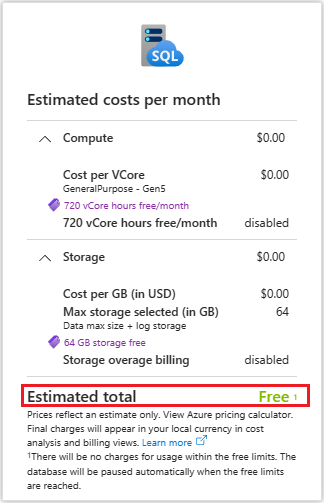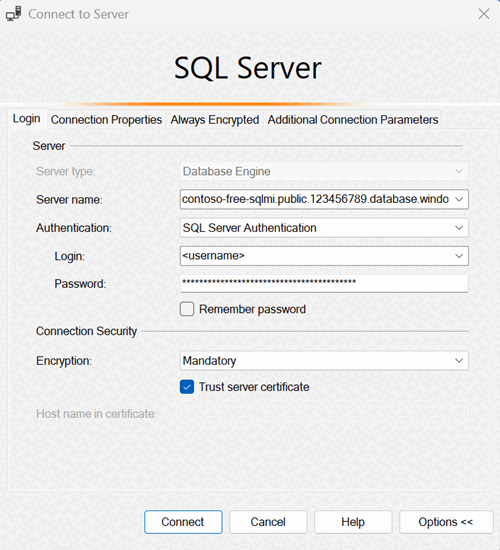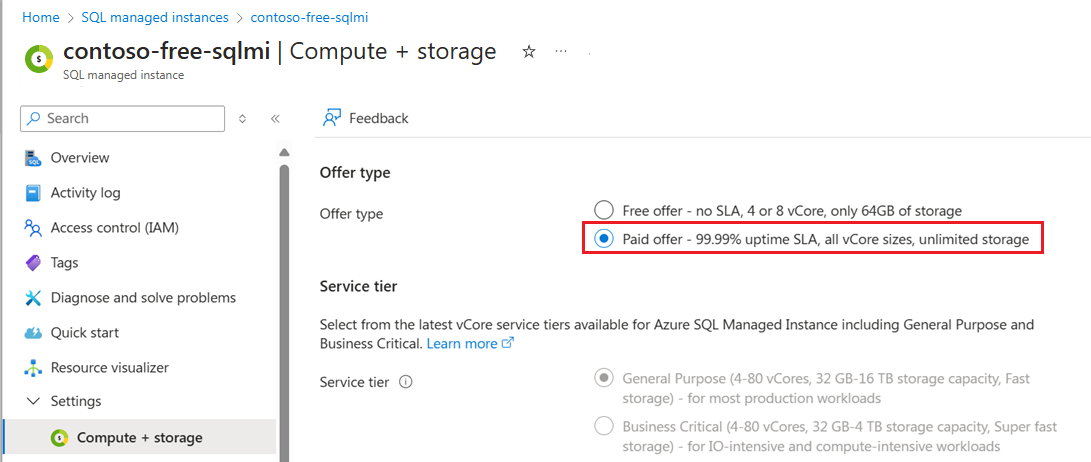Note
Access to this page requires authorization. You can try signing in or changing directories.
Access to this page requires authorization. You can try changing directories.
This article describes the free offer of Azure SQL Managed Instance, which gets you the following capacity free of charge for the first 12 months:
- a General Purpose or Next-gen General Purpose (preview) instance
- Up to 500 databases (based on the service tier)
- 720 vCore hours of compute every month
- 64 GB of storage
Overview
The free Azure SQL Managed Instance offer is designed for:
- New customers who want to explore SQL Managed Instance and get started with cloud-native SQL Server capabilities.
- Existing customers who need a development environment to build proof-of-concept applications.
- Testing existing SQL Server workloads in Azure before committing to a paid plan.
To get started, create a new Azure SQL Managed Instance from the Azure portal. To use the free offer, select Apply free offer from the banner at the top of the Create Azure SQL Managed Instance page, or select the Try for free link on the Azure SQL hub at aka.ms/azuresqlhub.

You know the offer is applied when the Cost summary card on the right side of the page shows Estimated total as Free.

What's included in the free offer
The free SQL Managed Instance offer includes:
- One General Purpose or Next-gen General Purpose SQL Managed Instance per subscription.
- 720 vCore hours every month for 12 months.
- Creating up to 500 databases in the Next-gen General Purpose service tier, or up to 100 databases in the General Purpose service tier.
- 64 GB of data storage.
- SQL license for the instance.
- Automatically backed up databases retained for up to seven days.
- Standard workday start/stop schedule enabled by default to ensure efficient use of credits.
- The instance automatically stops when you reach the monthly vCore limit. When you set the start/stop schedule on the instance, the next scheduled start succeeds when credits are available again.
- No extra charges are applied until you decide to upgrade to paid version.
Create a free instance
Use the Azure portal to create a free Azure SQL Managed Instance.
To create your free SQL managed instance, follow these steps:
On the Azure SQL Managed Instance tile, select Try for free to open the Create Azure SQL Managed Instance page, with the free offer already applied:
Alternatively, you can go to the Create Azure SQL Managed Instance page in the Azure portal directly, and then select Apply free offer from the banner at the top of the page.
Check the Estimated costs per month to validate the free offer is applied to your instance.
For Resource group, either select an existing resource group from the dropdown list or select Create new to create a new resource group. Enter the name of your resource group, such as
myFreeMIResourceGroupand then select OK.Instance details such as the name and region, are already populated with default values but you can choose to modify these values.
You can choose to leave the Compute + storage as default, or select Configure Managed Instance to update the number of vCores, and change the service tier from General Purpose to Next-gen General Purpose (preview).
Select your preferred authentication method. Select Next : Networking.
On the Networking tab, the public endpoint is enabled by default so you can connect to the instance from any application that can access the internet. You can choose to disable the public endpoint to test a closed environment and to connect to your instance.
Select Next: Security. You can choose to leave these options as default, or modify them as needed.
Select Next: Additional settings. You can choose to leave these options as default, or modify them as needed. The instance schedule is based on the time zone you configure on this page.
Select Review + create to review your settings and then use Create to create your free instance.
Connect to your instance
The way to connect to your instance depends on whether or not you disabled the public endpoint when you created your instance. For more information about endpoints, review Connectivity architecture.
Public endpoint enabled
When you apply the free offer to your instance, the public endpoint is enabled by default so you can connect to your instance from any application that can access the internet.
If your public endpoint is enabled, follow these steps to connect to your instance:
Go to your SQL Managed Instance in the Azure portal.
Under Security, select Networking and then copy the value from the Endpoint field, such as:
contoso-free-sqlmi.public.123456789.database.windows.net,3342You can also find connection strings to connect to your instance under Settings and then Connection strings.
Open your preferred data tool, such as SQL Server Management Studio (SSMS).
Select Connect and then paste the Endpoint value for the SQL Managed Instance you copied from the Azure portal into the server name field:

Select your preferred authentication method - either SQL Server Authentication or Microsoft Entra and provide credentials, if necessary.
Select Connect to connect to your SQL Managed Instance.
Public endpoint disabled
If you disable the public endpoint, you can choose to either Create an Azure VM within the same virtual network or Configure point-to-site to connect to your instance. Review Connect your application to Azure SQL Managed Instance for more information.
Default instance schedule
To conserve credits, the free instance is scheduled to be on from 9 a.m. to 5 p.m. Monday through Friday in the time zone configured when you created the instance. If no time zone is configured, the default time zone is UTC. The time zone can't be modified after the instance is created.
You can modify the schedule to suit your business needs.
Restore sample database
You can use your preferred query tool, such as SQL Server Management Studio (SSMS), to restore the sample Wide World Importers database to your free SQL Managed Instance.
To restore your database by using Transact-SQL in SQL Server Management Studio, follow these steps:
Connect to your free instance and open a new query window.
Run the following command to create a credential that accesses a publicly available storage account:
CREATE CREDENTIAL [https://mitutorials.blob.core.windows.net/examples/WideWorldImporters-Standard.bak] WITH IDENTITY = 'SHARED ACCESS SIGNATURE';Run the following command to check that your credential has access to the storage account:
RESTORE FILELISTONLY FROM URL = 'https://mitutorials.blob.core.windows.net/examples/WideWorldImporters-Standard.bak';Run the following statement to restore the sample Wide World Importers database:
RESTORE DATABASE [WideWorldImportersExample] FROM URL = 'https://mitutorials.blob.core.windows.net/examples/WideWorldImporters-Standard.bak';Run the following statement to track the status of your restore process:
SELECT session_id as SPID, command, a.text AS Query, start_time, percent_complete , dateadd(second,estimated_completion_time/1000, getdate()) as estimated_completion_time FROM sys.dm_exec_requests r CROSS APPLY sys.dm_exec_sql_text(r.sql_handle) a WHERE r.command in ('BACKUP DATABASE','RESTORE DATABASE');
Upgrade to paid instance
To use an unlimited paid Azure SQL Managed Instance, or if you run out of vCore hours, upgrade your free instance to a paid instance directly from the Azure portal.
To upgrade your instance, follow these steps:
Go to your SQL managed instance in the Azure portal.
Select the free instance you want to upgrade to navigate to the Overview page for the SQL Managed Instance.
Under Settings, select Compute + storage to open the Compute + storage page. Alternatively, you can select Upgrade to a paid offer from the banner on the Overview page.
On the Compute + storage page:
- Choose the Paid offer under Offer type to upgrade your instance to the paid version.
- Review the Estimated costs per month.
- Select Apply to confirm the upgrade.
Note
When you change a free SQL managed instance to a paid offer, the free offer is no longer available for that instance. To continue using the free offer, you must create a new instance and apply the free offer again.
Clean up resources
When you're done using your free Azure SQL Managed Instance or want to start fresh with a new one, you can delete the entire resource group or the individual instance. This action removes the instance and any associated databases.
To delete your resource group and all its resources by using the Azure portal, follow these steps:
- In the Azure portal, search for Resource groups in the top search bar and select it.
- Select your resource group from the list - such as
myFreeMIResourceGroup. - On the Resource group overview page, select Delete resource group.
- When prompted, type the name of the resource group to confirm.
- Select Delete to remove the group and all its resources.
Use a similar procedure to remove the individual free SQL managed instance resource.
Warning
Deleting a resource group is irreversible. Make sure you no longer need any of the resources it contains.
Free offer limits
The free Azure SQL Managed Instance offer is the same fully managed platform as a service (PaaS) instance you get with the paid version. It handles all of the same database management functions (such as upgrading, patching, backups, and monitoring) without user involvement. You can get one free instance per Azure subscription.
The following table describes the limits of the free SQL Managed Instance:
| Category | Limit |
|---|---|
| Compute | 4 or 8 vCore instances only |
| Databases | 100 (General Purpose) / 500 (Next-gen General Purpose) |
| vCore hours | 720 vCore hours monthly |
| Storage | 64 GB of data1 |
| IOPS | Depends on file size / 300 for Next-gen General Purpose2 |
| Instances per subscription | 1 |
| Service tiers | General purpose, and Next-gen General Purpose (preview) |
| Hardware | Standard only |
| Backup retention | 1-7 days for short term retention |
| SQL License cost | None |
| Guaranteed SLA | None |
1 Since system files can take up to 32 GB of storage, the available storage for user data could be less than 64 GB. 2 Free instances that use the Next-gen General Purpose (preview) service tier upgrade are limited to 300 IOPS, and the IOPS slider is unavailable.
Additionally, the following limitations apply:
- The offer is valid for 12 months from the day you activate the offer. You can apply it to only one instance at a time, per subscription.
- After 12 months, the free SQL managed instance stops. If you don't upgrade the instance to a paid version within 30 days, the instance and all databases are deleted and no longer recoverable.
- The following capabilities aren't supported: Zone redundancy, Failover groups, Long-term backup retention, modifying the backup storage redundancy.
- You can only scale up and down within the free offer limits.
- The free offer is currently available in the following regions.
- If you delete a free SQL managed instance, you delete all its databases and can't restore them.
Monthly vCore limits
The monthly free limits include 720 vCore hours of compute. Your free month of credits starts when you create your instance and renews on the same day of the following month.
When you reach the monthly free vCore limit, the instance stops with a status of Stopped - Insufficient credit. A banner on the Overview page of your instance in the Azure portal gives you the option to create a new paid instance. You can restore your database to the new instance to continue your business without the limits imposed by the free offer.
The free vCore hours renew on the same date each month, starting the day the offer is applied. If your instance stops due to insufficient credits, then after you have credits available again, the instance starts automatically at the next scheduled start. You can also stop the instance manually at any time to avoid using up your free monthly vCore hours.
On the Overview pane of your free instance in the Azure portal, you can identify:
- Pricing tier: the free offer applied to your instance.
- Free vCore hours renew in: the number of days until your free vCore hours recycle.
- Free vCore hours: the remaining free vCore hours for the current 30-day cycle.
Note
If you delete your original free SQL Managed Instance and create a new one, your free credits don't reset. The remaining vCore hours for the current month carry over to the new instance and your full 720 vCore hours are available again on your original monthly renewal date.
Supported subscription types
The free Azure SQL Managed Instance offer is available on the following subscription types:



